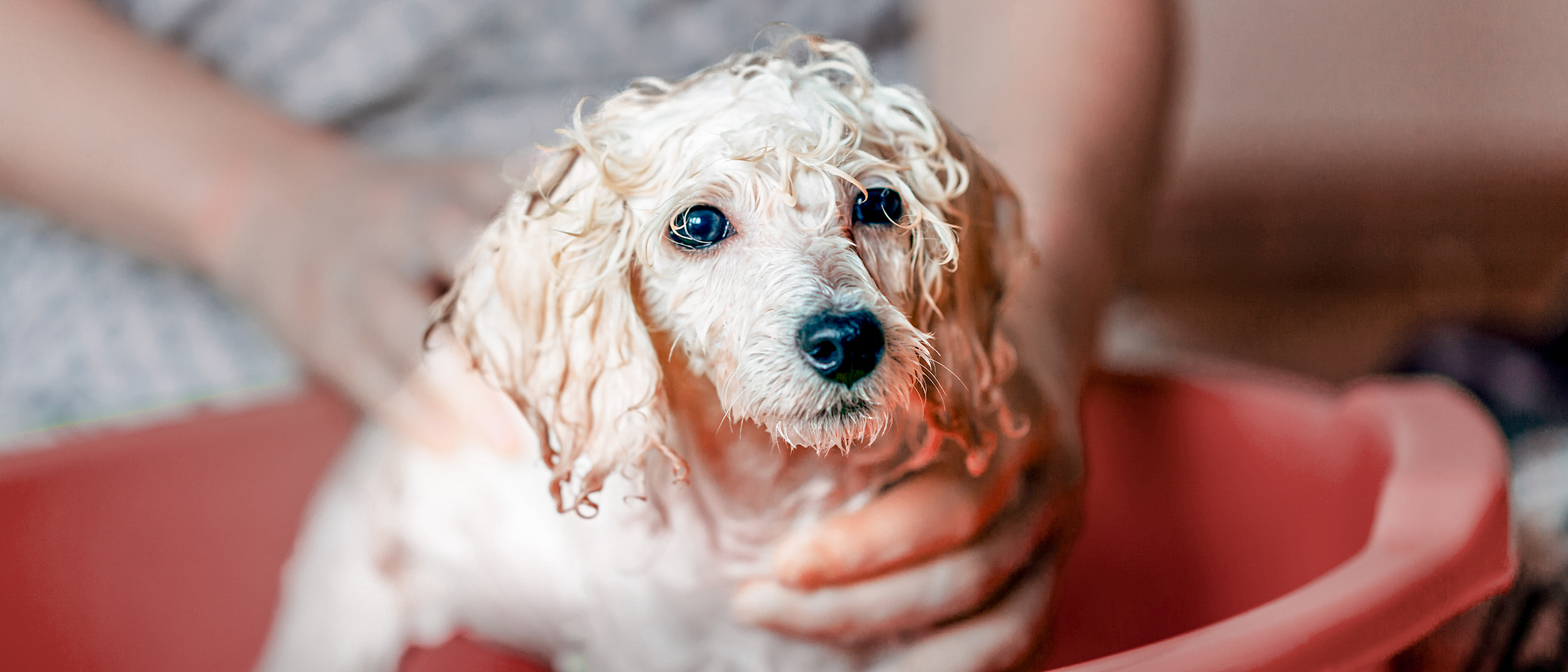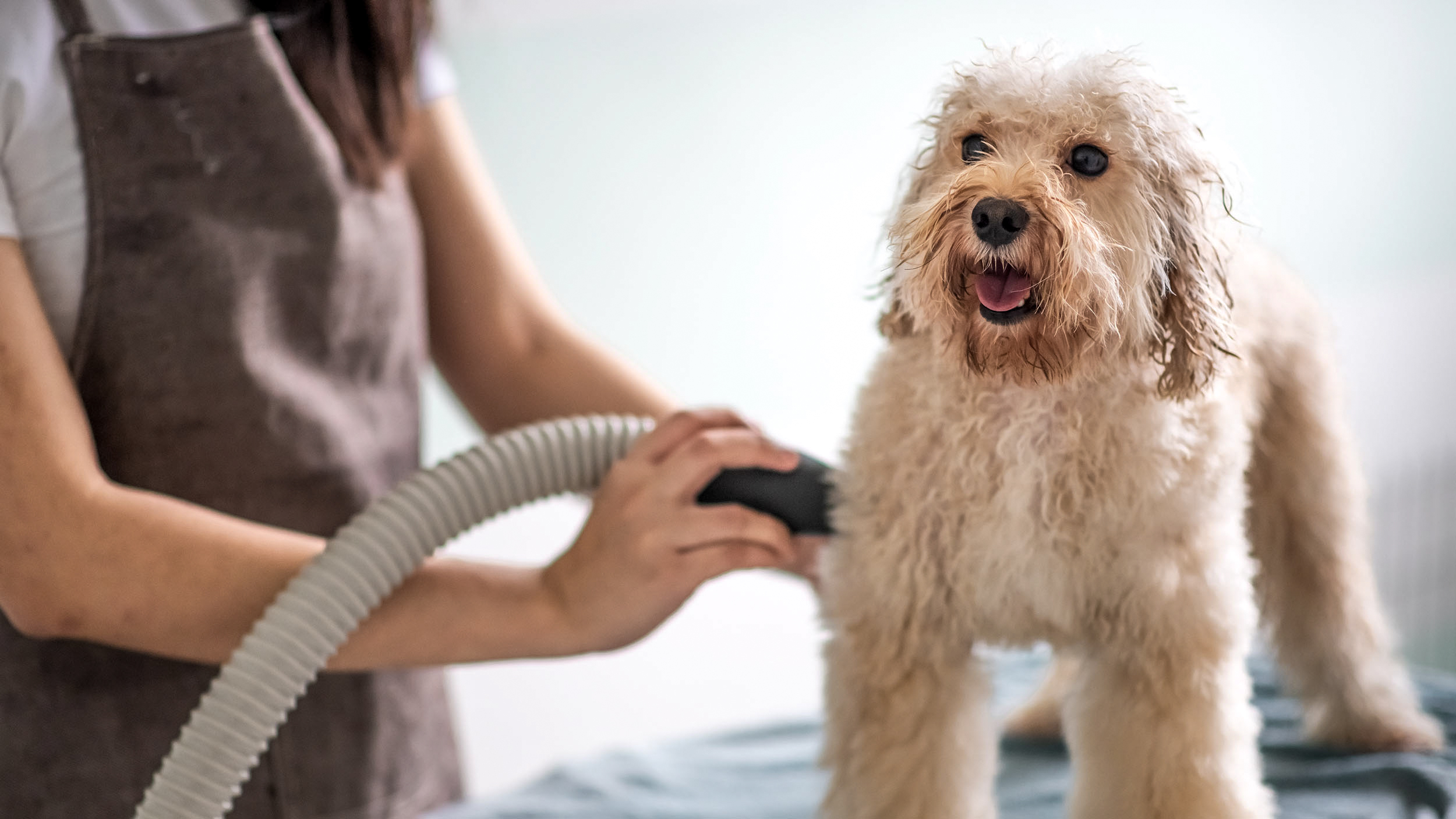Grooming and hygiene tips for your new puppy

How to bathe a puppy
The frequency of baths will vary according to the coat texture. Close-cropped hair should only be washed if dirty, short-haired puppies need to be bathed twice a year on average and long-haired puppies need to be bathed approximately every three months.
If your dog likes swimming, its coat should be rinsed afterwards. Particles from river and seawater remaining on the coat may cause irritation, and careful rinsing will prevent this.
Start the bathing process by brushing the coat thoroughly to get rid of any knots and mats. After this, wet the coat all over and apply the shampoo, working it into a lather, while taking care that it doesn’t get in the dog’s eyes or ears. Lukewarm water should be used, along with a special shampoo for puppies to avoid irritation or an imbalance to their skin's natural pH.
Allow this to act for a few minutes, then rinse with plenty of water. It’s a good idea to rinse the head last, as the dog will likely want to shake its head dry.
Drying your puppy after a bath
After the bath, wipe your puppy down vigorously and keep it in a warm room until it’s properly dry. In the summer, the alternative is patting a puppy down in the garden or taking it for a walk, as long as it does't like rolling around in mud. A hairdryer can be used if the dog is happy with that, but care should be taken not to burn the dog and the hair should be brushed at the same time.
How to clean tar from your puppy's coat
It's important to note that if the dog gets tar on its coat, oil-based cleaning products shouldn't be used as they are highly toxic. Apply vegetable oil to affected areas, wait a few minutes for it to dissolve the tar, then bathe the dog.
Trimming a puppy's nails
Dogs have two types of nail - dewclaw and toenails - both of which grow constantly. Toenails should wear down naturally, but if they grow too long they need to be clipped.
All puppies need proper nail care. Generally puppies don’t need to have their nails trimmed but if you can hear the noise the nails make on the ground, you can clip them. Ask your veterinarian to demonstrate the best techniques.
Brushing and combing your puppy
As with humans, a dogs hair will grow and die. Outdoor dogs shed their coat twice a year (spring and autumn) corresponding to the changes in daylight. Indoor dogs are not as affected by changes in light, so they shed hair throughout the year, with two periods of increased shedding in spring and autumn. Regular brushing and bathing will help remove loose hair. The frequency and the type of equipment used will vary depending on the nature of the coat.
Brushing puppies with close-cropped hair
While close-cropped hair does not require regular grooming, it does need to be brushed occasionally. Dead skin and hair is loosened by brushing against the hair with a rubber brush. The debris can then be removed by using a bristle brush in the direction of the hair over the whole body. Finish by adding sheen to the coat with a damp chamois.
Grooming puppies with short or medium length hair
These dogs should be brushed more frequently - at least once a week - due to the density of their coat, which is comprised of both an undercoat and a topcoat. Use a slicker brush, working against the hair to loosen as much dead hair and skin as possible and strip the undercoat. A bristle brush can then be used in the direction of the hair to remove the debris.
A wide-tooth comb can be used on the tail and paws. The coat of coarse-haired dogs needs to be stripped four to five times a year with a stripping knife and thumb. This is not at all painful if done properly, working in the direction of their hair.
Brushing puppies with long hair
Although beautiful, longhaired coats require daily brushing. This can take up to an hour a day in Afghan Hounds, for example. Use a slicker brush, working in the direction of the hair, to loosen knots and mats. Because the hair is long, this may pull the skin, so care should be taken to avoid hurting the puppy.
Using a bristle brush on dogs with silky coats, like Yorkshire Terriers and Afghan Hounds, will add sheen to the coat.
A wire brush can be used to remove impurities from the coat of dogs with an abundant undercoat, like Rough Collies.
A wide-tooth comb can be used to untangle hair behind the hocks.
All grooming tools should be cleaned and stored in a dry location after every use. Keep wire brushes from rusting by wiping them well and rubbing them with a rag soaked in vegetable oil.

Puppy oral care
Dogs are rarely happy to allow people to manipulate their mouth, so it's a good strategy to get a puppy used to this from an early age.
The gums should be pink. Redness around the teeth is a sign of inflammation and disease, which can cause a loss of appetite if it is painful or the dog is unable to grasp or chew its food. In this case, the dog’s teeth should be examined by a veterinarian.
How to brush a puppy's teeth
The best way to care for your puppy's teeth is by brushing them several times a week with a toothbrush and toothpaste specifically designed for dogs.
Chewing bars that slow down the formation of plaque and tartar by acting mechanically on the teeth when the dog chews are another alternative. Ideally, the dog should be given two or three of these chewing bars a week to help prevent plaque and tartar build-up. Ask your veterinary team which type is best for your dog.
Cleaning your puppy's ears
Dogs carry their ears in one of two ways, either drop or prick. Drop ears should be examined more often because the ear canal is less well ventilated.
Ears may be cleaned under the advice of a vet, with a specially formulated solution. Place the tip of the applicator into the ear canal and gently squeeze in 1 to 2 drops. Withdraw the tip and massage the base of the ear very gently for thirty seconds, preventing the dog from shaking its head, before wiping the ear flap with cotton wool.
Keeping your puppy's eyes clean
The eyes should be bright and moist, with pale pink mucosae. It’s important to clean your puppy’s eyes of any discharge, but there will always be some amount of tear-staining whenever hair rests around the eyes. Tear-staining results from the hair absorbing moisture produced by the eyes.
Dirt or mud and tear-staining around the eyes can be removed gently with cotton wool and clean, lukewarm water.
Whether you plan on taking your dog to a groomer as an adult or not, familiarising them with grooming and hygiene routines from a young age will ensure that they get used to being handled and will help avoid any distress that might occur when grooming older dogs.
Tailored nutrition for your puppy
A range of formulas that help build their natural defences, support healthy growth and digestive system development.
Like & share this page